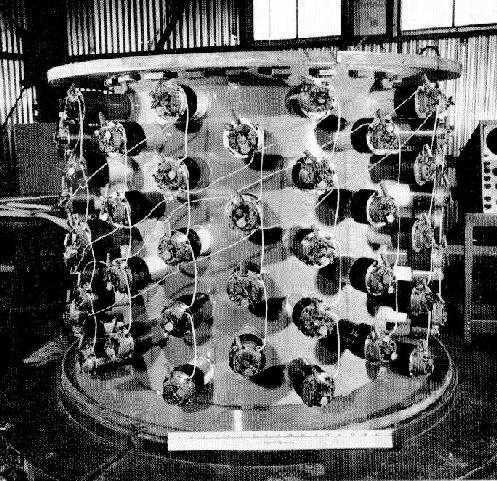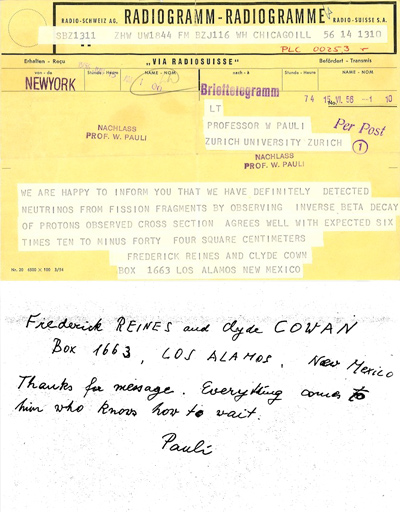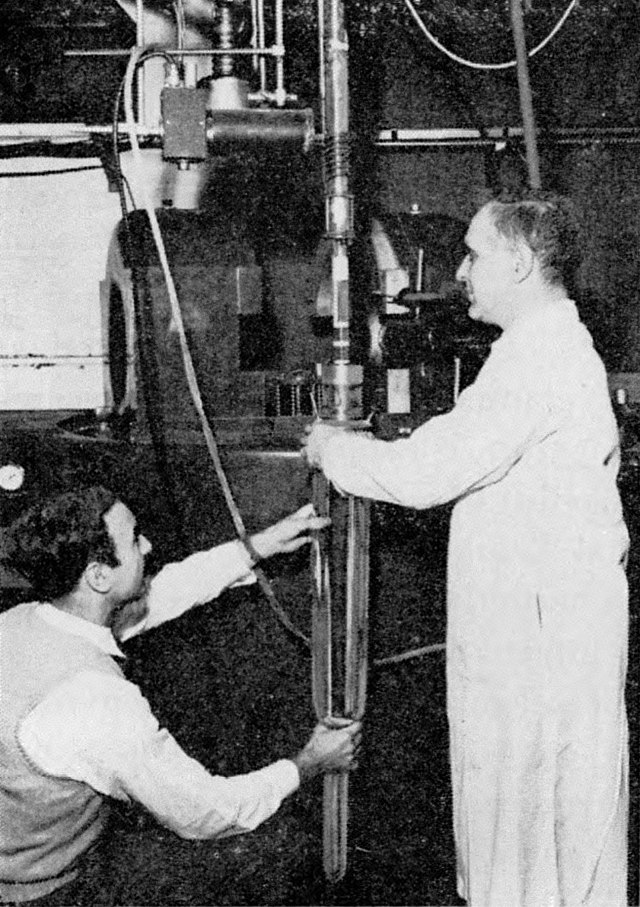In spite of the prediction by Bethe and Peierls [Bet34], several physicists attempted to see the neutrino, among them Nahmias, Crane, Allen [Nah35,Cra38,All42]. Until the end of the 1940’s, they tried to measure the recoil of a nucleus during its beta decay. All the measurements were compatible with the hypothesis of only one neutrino emitted with the electron. In 1946, Bruno Pontecorvo, then in Canada, proposed to use the inverse beta-process (ν + Z → e⁻+ [Z+1]) to detect the neutrinos, mentioning the famous chlorine-argon reaction (νe+ 37Cl →e⁻+ 37Ar) followed by the observed 37Ar decay [Pon46], and quoting the Sun and nuclear reactors as significant sources of neutrinos. In 1949, Alvarez proposed an experiment based on this reaction but did not realize it [Alv49].

In the early 50’s, Frederick Reines, in Los Alamos, considered the Pontecorvo’s idea that you need a very intense source of neutrinos, as well as a very sensitive and huge detector. He met Clyde Cowan and they first had the idea to place their apparatus close to an atomic explosion, but the background was too high (see the paper by Fred Reines and Clyde Cowan in [Los97]). In October 1952, they agreed to use a more peaceful and convenient source of neutrinos: the nuclear plant of Hanford (Washington). They wrote to Fermi who encouraged them, writing that “the new method has the advantage that the measurement can be repeated any number of times”.
So, they started a project named “Poltergeist”. The detector was built quickly. Their experiment, proposed in February 1953, was realized in spring and their results came out during the summer 1953. But the signal was not sufficiently significant with respect to the background [Rei53]. They improved the detector and redid their experiment in 1956, more carefully and installed it near the nuclear plant of Savannah River (South Carolina). This time, they were able to decrease the background and to give to the neutrino signal a significance above 4 sigma, which means that backgrounds like the cosmic rays interacting with the detector had only 1 chance over 1 million to fake the neutrino signal [Cow56]. On June 14, they sent a telegram to Pauli to announce him the discovery of the neutrino. He answered simply: “Thanks for message. Everything comes to him who knows how to wait”.
The Reines and Cowan experiment used a target made of about 400 liters of a mixture of water and cadmium chloride. The anti-neutrinos coming from the nuclear reactor interact with a proton of the target matter, giving a positron and a neutron (νe+ p → e⁺+ n). The positron annihilates with an electron of the surrounding material, giving two simultaneous photons and the neutron slows down until its capture by a cadmium nucleus, implying the emission of photons some 15 microseconds after those of the positron annihilation. All those photons are detected and the 15 microseconds identify the neutrino interaction. More details can be found in the Reines-Cowan paper in the special issue of Los Alamos Science [Los97].

The discovery was not a real surprise: the beta-decay theory by Fermi was so successful that everybody already believed in the reality of the neutrino. Reines and Cowan closed brilliantly a chapter, 25 years after Pauli’s idea. They received for this a telegram from a not astonished Wolfgang Pauli.

In 1955, Ray Davis installed a first chlorine-argon detector close to a nuclear reactor in Brookhaven but he did not observe any event [Dav55]. His experiment was bet that anti-neutrinos emitted by reactors could be detected by the chlorine-argon detector which is sensitive only to neutrinos. Davis was later more successful with the Sun.
From this, neutrinos fully take part in the game of particle physics. In 1957, T.D. Lee and C.N. Yang suggested that parity was not conserved in beta-decay and proposed a two-component theory of the neutrino [Lee56,Lee57]. Few weeks later, C.S. Wu and her collaborators observed experimentally that parity was not conserved in beta decay [Wu58]. At the end of 1957, Maurice Goldhaber and his collaborators found in a beautiful experiment that the neutrino was left-handed (had a negative helicity) [Gol58].
References
| Author(s) | Title | Reference | Key-words | |
|---|---|---|---|---|
| Bet34 | H. Bethe and R. Peierls | The neutrino | Nature 133 (1934) 532 | historical properties detection milestonebib overviewbib prehistbib discovbib |
| Nah35 | M.E. Nahmias | An attempt to detect the neutrino | Proc. Cambridge Phil. Soc. 31 (1935) 99 | historical properties detection discovbib |
| Cra38 | H.R. Crane and J. Halpern | The experimental evidence for the existence of a neutrino | Phys. Rev. 53 (1938) 789 | historical detection discovbib |
| All42 | J.S. Allen | Experimental evidence for the existence of a neutrino | Phys. Rev. 61 (1942) 692 | historical detection discovbib |
| Pon46 | B. Pontecorvo | Inverse beta process | Report PD-205 of the National Research Council of Canada, Division of Atomic Energy, Chalk River, Ontario, Nov. 13, 1946 (available in *Winter, K. (ed.): Neutrino physics*, p.25, in *Pontecorvo, B.: Selected scientific works*, p. 21, in *Bahcall, J.N. (ed.) et al.: Solar neutrinos* 97-106) - Reprint in “Neutrino Physics”, ed. by K. Winter, Cambridge University Press, 1991 | historical detection milestonebib overviewbib discovbib nuantinubib |
| Alv49 | L.W. Alvarez | A proposed Experimental Test of the Neutrino Theory | UCRL Report 328 (1949) | historical detection discovbib nuantinubib |
| Rei53 | F. Reines and C.L. Cowan | Detection of the free neutrino | Phys. Rev. 92 (1953) 830 | historical detection milestonebib overviewbib discovbib reactorbib plotbib |
| Dav55 | Raymond Davis Jr. | Attempt to Detect the Antineutrino from a Nuclear Reactor by the 37Cl(neutrino,e-)37Ar reaction | Phys. Rev. 97 (1955) 766 | historical properties detection numbernu discovbib solarbib nuantinubib |
| Cow56 | C.L. Cowan, F. Reines, F.B. Harrison, H.W. Cruse and A.D. McGuire | Detection of the free neutrino: a confirmation | Science 124 (1956) 103, July 20, 1956 - Reprint in “Neutrino Physics”, ed. by K. Winter, Cambridge University Press, 1991 | historical detection milestonebib overviewbib discovbib reactorbib plotbib detectorbib |
| Lee56 | T.D. Lee and C.N. Yang | Question of Parity Conservation in Weak Interactions | Phys. Rev. 104 (1956) 254 | historical properties milestonebib discovbib propbib |
| Rei56 | Frederick Reines and Clyde Cowan jr. | The neutrino | Nature 178 (1956) 446 | historical detection milestonebib overviewbib discovbib reactorbib plotbib |
| Gar57 | Richard L. Garwin, Leon M. Lederman and Marcel Weinrich | Observations of the failure of conservation of parity and charge conjugation in meson decays | Phys. Rev. 105 (1957) 1415 | historical properties betadecay milestonebib overviewbib discovbib propbib |
| Lee57 | T.D. Lee and C.N. Yang | Parity non-conservation and a two-component theory of the neutrino | Phys. Rev. 105 (1957) 1671 | historical properties milestonebib overviewbib discovbib propbib |
| Wu57 | C.S. Wu, E. Ambler, R.W. Hayward, D.D. Hoppes, R.P. Hudson | Experimental test of parity conservation in beta decay | Phys. Rev. 105 (1957) 1413 | historical properties betadecay milestonebib overviewbib discovbib propbib |
| Gol58 | M. Goldhaber, L. Grodzins, A. Sunyar | Helicity of neutrinos | Phys. Rev. 109 (1958) 1015 | historical properties milestonebib overviewbib discovbib propbib theorybib plotbib detectorbib |
| Gro58 | L. Grodzins | Lifetime of a 1- level in 152Sm | Phys. Rev. 109 (1958) 1014 | historical properties discovbib propbib theorybib |
| Los97 | Los Alamos | Celebrating the neutrino | Los Alamos Science 25 | book history discovbib plotbib |

Je ne sais pas si la terminologie “inverse bêta process” pour nu + Z -> e- + (Z+1) est standard. N’y a-t-il pas un risque de confusion avec “inverse bêta decay”, qui désigne nubar + p -> n + e+ ?